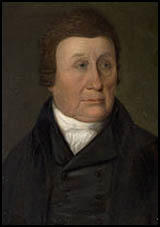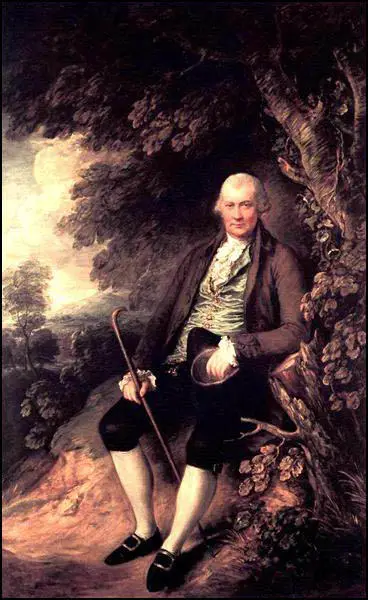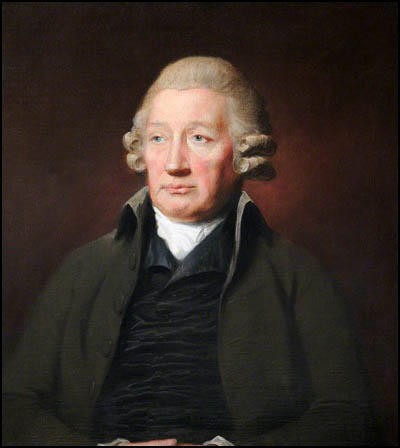John Wilkinson

John Wilkinson, the eldest son of Isaac Wilkinson, an ironmaster, and his wife, Mary Johnson, was born in 1728. John was educated at the dissenting academy at Kendal, Westmorland, run by Dr Caleb Rotherham. On leaving the academy at the age of seventeen, he was apprenticed to a Liverpool merchant for five years and then returned to enter into partnership with his father. (1)
Isaac Wilkinson had "worked at various coke-fired furnaces and had a number of patents to his name, the most successful of which was for a hollow 'box-iron', used in the textile business for smoothing cloth, especially linen". (2)
On 12th June 1755, he married Ann Maudesley at Kirkby Lonsdale. The following year a daughter, Mary, was born. Ann died on 17 November 1756, shortly after that he moved to Bersham Ironworks, where his father had established a new business. John now managed this, and other nearby foundries. (3)
John Wilkinson married Mary Lee, a wealthy woman who was the main shareholder in the family ironworks. She provided him with the money to establish his own coke-fired furnace. Wilkinson developed a reputation for high-quality casting. He developed a technique for boring iron guns from the solid, rotating the gun barrel rather than the boring-bar. This method produced guns less likely to explode and with a more accurate bore. (4)
John Wikinson and James Watt
In March 1773 John Roebuck, the owner of Carron Ironworks near Falkirk in Scotland, was forced into bankruptcy. At the time he owed Matthew Boulton over £1,200. Roebuck had been working very closely with the inventor, James Watt, who was developing a steam-engine that could power machinery. Boulton knew about Watt's research and wrote to him making an offer for Roebuck's share in the steam-engine. Roebuck refused but on 17th May, he changed his mind and accepted Boulton's terms. James Watt was also owed money by Roebuck, but as he had done a deal with his friend, he wrote a formal discharge "because I think the thousand pounds he (Boulton) he has paid more than the value of the property of the two thirds of the inventions." (5)
Boulton pointed out that before he would give Watt financial backing, he insisted that the 1769 patent, with only eight years to run, should be extended to twenty-five years. This meant petitioning the House of Commons. By 1775 the two men had their patent which gave them "the sole use and property of certain steam-engines of his invention, throughout the majesty's dominions." This prevented others from making steam-engines which contained improvements of their own. (6)
In 1775 Boulton persuaded Watt to make a steam machine that was far bigger than those he had been producing. It was a 38-inch cylinder, to provide blast for Wilkinson's furnaces at New Willey in Shropshire. Boulton told Watt that if Wilkinson's engine worked, his neighbouring iron-masters would also buy them. The two large cylinders were cast and bored by Wilkinson. (7)
Wilkinson devised a new lathe, the cylinder lathe, for the more accurate casting of cylinders. Watt was very impressed with these cylinders and as a result Wilkinson established a virtual monopoly in their production. Wilkinson was capable of producing boring engine cylinders with greater accuracy than any other iron-founder. His boring machine has been called the first machine tool that was developed during the industrial revolution. (8)
Production in France
Wilkinson began setting up forges at his works to employ the process for the conversion of coke-pig to wrought iron. His forges used steam-powered hammers worked by Boulton and Watt engines. The three men also joined forces to supply engines for the Paris water company of which Jean-Claude Perier was the engineer and leading entrepreneur. Watt obtained a fifteen-year patent in France in 1778 and Perier built two engines at Chaillot on the outskirts of Paris. (9)

John Wilkinson by Thomas Gainsborough (1776)
Attempts were made to persuade Wilkinson to establish a business in France. Marchand de la Houillère visited him at Bersham and made him an offer: "Being a zealous military man and having the interests of the King's service at heart, I was suddenly seized with the idea of bringing to France an experienced man capable of fulfilling this object, and he ventured to drop certain vague hints to an eminent ironmaster who owns four foundries and has brought the casting of cannon to the highest pitch of perfection, to the effect that an Englishman who would come to France and cast them in a similar manner, would make a large fortune." (10)
Wilkinson was interested in the offer but rejected the idea of being funded by the French government. However, he was willing to form a partnership with Marchand de la Houillère. It was agreed that Wilkinson was given "a guaranteed market for twelve years for the products of a French ironworks, exemption from all tax on coal, the freedom to export cannon and cannon balls when and where he liked" and an ironworks was established close to Nantes. (11)
Ironmaster
In 1779 Wilkinson became involved in the construction of the world's first iron bridge over the Severn. He also had two iron canal barges and a river barge built. During this period he obtained the soubriquet "Iron Mad" because he firmly believed that anything could be made of his metal. "He had an iron desk and an iron bed and kept an iron coffin propped up in his office to persuade others to place orders". (12)
François de La Rochefoucauld visited Wilkinson in 1785. "Mr Wilkinson is one of the greatest ironmasters in the world. He has acquired immense wealth, mostly by his genius... We didn't find Mr Wilkinson: he was in bed with a heavy cold he had caught in London. He read the letter we had brought him and sent us to his nearest ironworks where his agent showed us everything they were doing." He reported that the men were working very hard at the works: "Seeing them at work, I reflected as I very often have before: how lucky I am to be born into a position in which I don't have to work in order to live... What a miserable fate! What a price our luxury costs!" (13)
In 1786 John Wilkinson began providing miles of iron piping for a entirely new system of water supply for Paris. He also arranged for the installation of steam engines, made by Boulton and Watt, to pump water from the Seine into storage reservoirs. This was at a time when England and France were at war with each other and rumours began to circulate that Wilkinson was supplying the enemy with cannons disguised as water pipes. (14)
Wilson's sister, Mary, married the scientist and philosopher, Joseph Priestley, the author of The First Principles of Government and the Nature of Political, Civil and Religious Liberty (1768), The State of Public Liberty in General and of American Affairs in Particular (1774) and The History of the Corruptions of Christianity (1782). Wilkinson seemed to be sympathic to Priestley's radical political and religious views and bought him a house in Birmingham. He also provided financial support to his brother-in-law when his house was burnt down in 1791. (15)
Like many contemporary industrialists Wilkinson overcame the shortage of regal coin by issuing his own trade tokens, which were of high quality and displayed his own head and the inscription "John Wilkinson Ironmaster". On the reverse was a smithy, with two large tilt-hammers. This was the first coin to bear a head other than the monarch's and it caused great political controversy. (16)

In 1792 Wilkinson bought the Brymbo Hall estate near Wrexham, where furnaces and other plant were installed. It has been estimated that by 1796 he was producing one-eighth of the nation's iron (15,274 tons). Wilkinson was also important in the lead industry, being a major investor in Minera and other mines in north Wales. He had devised a process for producing lead pipe and had a works and depot for this at Rotherhithe. (17)
The developments in production introduced by Wilkinson meant that ironmakers were able to use coal instead of coke. These changes enabled the production of cast iron in Britain to increase from about 20,000 tons in 1720 to 250,000 tons by the end of the century. (18)
Wilkinson and his second wife Mary had no children, she being about forty at the time of their marriage. However, he had a series of mistresses, some of whom were his servants. He also had a regular mistress, Ann Lewis, by whom he had three children when in his seventies. After his wife's death in 1806, he legitimized these children and bequeathed his property in trust to them, but he did leave his main home, Castlehead, to Ann. (19)
John Wilkinson died at Bradley on 14 July 1808 and was buried at Lindale in Cumbria. However, he had put on a lot of weight in his later years and the iron coffin was too small and was buried in a wooden one. An iron obelisk was erected above his grave in his memory. (20)
Primary Sources
(1) Gavin Weightman, The Industrial Revolutionaries (2007)
Wilkinson settled in Broseley and soon had complete charge of the works, which made great profits casting naval cannon and shot for the British government, and indeed for anyone else prepared to pay, including privateers. At the same time, John went into partnership with Isaac, his father. But their commercial ventures together failed and they fell out. Old Isaac died a bankrupt while John went on to make a success of the business. In 1774 he took out a patent which was to become his greatest claim to fame: an elaborate mechanism for boring out the barrels of iron cannon from a solid mould. Versions of this boring system had been in existence for a number of years, but Wilkinson's machine was an improvement on them, with the cannon itself being rotated while the cutter was held steady.
(2) Roger Osborne, Iron, Steam and Money: The Making of the Industrial Revolution (2013)
Immediately after the patent was extended Boulton and Watt came to a financial agreement. Boulton discharged all existing debts on the project, agreed to meet all costs of experiment and pay Watt £300 a year, in return for two-thirds of the earnings for the duration of the patent. Boulton immediately urged Watt to draw up plans for a pumping engine for Bloomfield colliery at Tipton in Staffordshire, which would contain a fifty-inch-diameter cylinder, a huge step up from Watt's twelve-inch experimental engine. They also drew up plans for a thirty-eight-inch cylinder blowing engine for the blast furnace at John Wilkinson's ironworks at New Willey in Shropshire. Wilkinson was commissioned to supply the iron cylinders; the Bloomfield engine was built to Watt's satisfaction and set running on 8 March 1776.
The blowing engine for Wilkinson's ironworks began powering the furnace at about the same time; both machines were successful. They used a fraction of the fuel of Newcomen engines and, while the early installations needed constant repair, they provided useful experience for Boulton and Watt and evidence to the wider world that Watt's engines really did work. It had taken Watt eleven years to construct the first working engine - about the same time as Newcomen had spent on realising his idea. The year 1776 saw the birth of the nation that was to epitomise the modern world; it also saw the first running of a machine that was to change the fate of humanity.
Student Activities
Child Labour Simulation (Teacher Notes)
Road Transport and the Industrial Revolution (Answer Commentary)
Richard Arkwright and the Factory System (Answer Commentary)
Robert Owen and New Lanark (Answer Commentary)
James Watt and Steam Power (Answer Commentary)
The Domestic System (Answer Commentary)
References
(1) John R. Harris, John Wilkinson : Oxford Dictionary of National Biography (2004-2014)
(2) Gavin Weightman, The Industrial Revolutionaries (2007) page 26
(3) Jenny Uglow, The Lunar Men (2002) page 252
(4) Thomas Southcliffe Ashton, The Industrial Revolution 1760-1830 (1948) page 56
(5) Gavin Weightman, The Industrial Revolutionaries (2007) page 55
(6) Edward Baines, History of the Cotton Manufacture in Great Britain (1835) page 224
(7) Jenny Uglow, The Lunar Men (2002) pages 253-254
(8) Jennifer Tann, James Watt : Oxford Dictionary of National Biography (2004-2014)
(9) Roger Osborne, Iron, Steam and Money: The Making of the Industrial Revolution (2013) page 127
(10) John R. Harris, Industrial Espionage and Technology Transfer: Britain and France in the 18th Century (2000) page 247
(11) Gavin Weightman, The Industrial Revolutionaries (2007) page 28
(12) Jenny Uglow, The Lunar Men (2002) page 252
(13) François de La Rochefoucauld, Tour of England (1785)
(14) Gavin Weightman, The Industrial Revolutionaries (2007) pages 22-23
(15) Robert E. Schofield, Joseph Priestley : Oxford Dictionary of National Biography (2004-2014)
(16) Jenny Uglow, The Lunar Men (2002) page 417
(17) John R. Harris, John Wilkinson : Oxford Dictionary of National Biography (2004-2014)
(18) Roger Osborne, Iron, Steam and Money: The Making of the Industrial Revolution (2013) page 239
(19) John R. Harris, John Wilkinson : Oxford Dictionary of National Biography (2004-2014)
(20) Jenny Uglow, The Lunar Men (2002) page 252
